Guillaume Lample
Pixtral 12B
Oct 09, 2024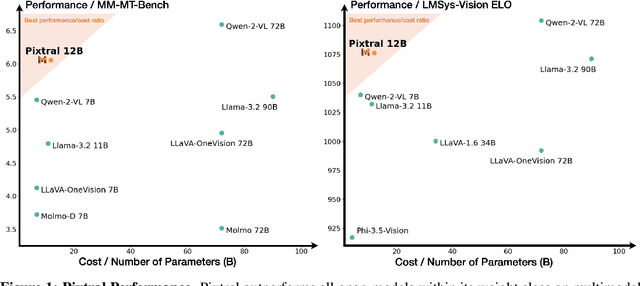
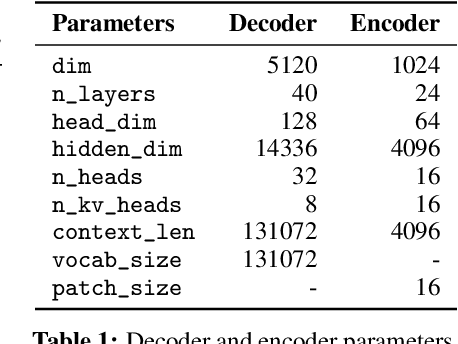
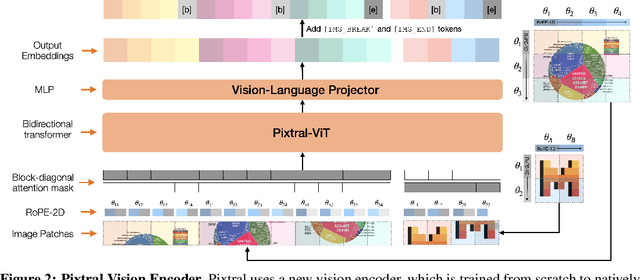
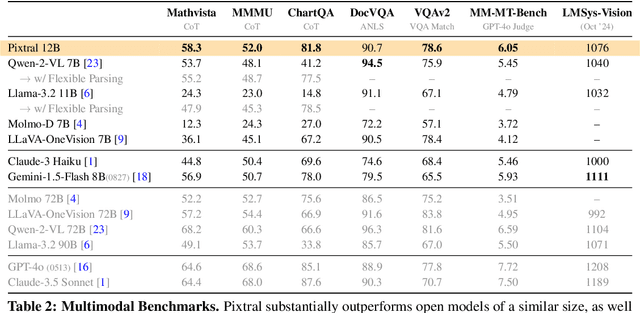
Abstract:We introduce Pixtral-12B, a 12--billion-parameter multimodal language model. Pixtral-12B is trained to understand both natural images and documents, achieving leading performance on various multimodal benchmarks, surpassing a number of larger models. Unlike many open-source models, Pixtral is also a cutting-edge text model for its size, and does not compromise on natural language performance to excel in multimodal tasks. Pixtral uses a new vision encoder trained from scratch, which allows it to ingest images at their natural resolution and aspect ratio. This gives users flexibility on the number of tokens used to process an image. Pixtral is also able to process any number of images in its long context window of 128K tokens. Pixtral 12B substanially outperforms other open models of similar sizes (Llama-3.2 11B \& Qwen-2-VL 7B). It also outperforms much larger open models like Llama-3.2 90B while being 7x smaller. We further contribute an open-source benchmark, MM-MT-Bench, for evaluating vision-language models in practical scenarios, and provide detailed analysis and code for standardized evaluation protocols for multimodal LLMs. Pixtral-12B is released under Apache 2.0 license.
Mixtral of Experts
Jan 08, 2024



Abstract:We introduce Mixtral 8x7B, a Sparse Mixture of Experts (SMoE) language model. Mixtral has the same architecture as Mistral 7B, with the difference that each layer is composed of 8 feedforward blocks (i.e. experts). For every token, at each layer, a router network selects two experts to process the current state and combine their outputs. Even though each token only sees two experts, the selected experts can be different at each timestep. As a result, each token has access to 47B parameters, but only uses 13B active parameters during inference. Mixtral was trained with a context size of 32k tokens and it outperforms or matches Llama 2 70B and GPT-3.5 across all evaluated benchmarks. In particular, Mixtral vastly outperforms Llama 2 70B on mathematics, code generation, and multilingual benchmarks. We also provide a model fine-tuned to follow instructions, Mixtral 8x7B - Instruct, that surpasses GPT-3.5 Turbo, Claude-2.1, Gemini Pro, and Llama 2 70B - chat model on human benchmarks. Both the base and instruct models are released under the Apache 2.0 license.
Mistral 7B
Oct 10, 2023



Abstract:We introduce Mistral 7B v0.1, a 7-billion-parameter language model engineered for superior performance and efficiency. Mistral 7B outperforms Llama 2 13B across all evaluated benchmarks, and Llama 1 34B in reasoning, mathematics, and code generation. Our model leverages grouped-query attention (GQA) for faster inference, coupled with sliding window attention (SWA) to effectively handle sequences of arbitrary length with a reduced inference cost. We also provide a model fine-tuned to follow instructions, Mistral 7B -- Instruct, that surpasses the Llama 2 13B -- Chat model both on human and automated benchmarks. Our models are released under the Apache 2.0 license.
LLaMA: Open and Efficient Foundation Language Models
Feb 27, 2023



Abstract:We introduce LLaMA, a collection of foundation language models ranging from 7B to 65B parameters. We train our models on trillions of tokens, and show that it is possible to train state-of-the-art models using publicly available datasets exclusively, without resorting to proprietary and inaccessible datasets. In particular, LLaMA-13B outperforms GPT-3 (175B) on most benchmarks, and LLaMA-65B is competitive with the best models, Chinchilla-70B and PaLM-540B. We release all our models to the research community.
Deep Generative Symbolic Regression with Monte-Carlo-Tree-Search
Feb 22, 2023Abstract:Symbolic regression (SR) is the problem of learning a symbolic expression from numerical data. Recently, deep neural models trained on procedurally-generated synthetic datasets showed competitive performance compared to more classical Genetic Programming (GP) algorithms. Unlike their GP counterparts, these neural approaches are trained to generate expressions from datasets given as context. This allows them to produce accurate expressions in a single forward pass at test time. However, they usually do not benefit from search abilities, which result in low performance compared to GP on out-of-distribution datasets. In this paper, we propose a novel method which provides the best of both worlds, based on a Monte-Carlo Tree Search procedure using a context-aware neural mutation model, which is initially pre-trained to learn promising mutations, and further refined from successful experiences in an online fashion. The approach demonstrates state-of-the-art performance on the well-known \texttt{SRBench} benchmark.
HyperTree Proof Search for Neural Theorem Proving
May 23, 2022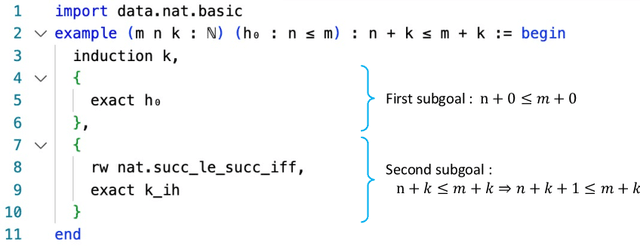

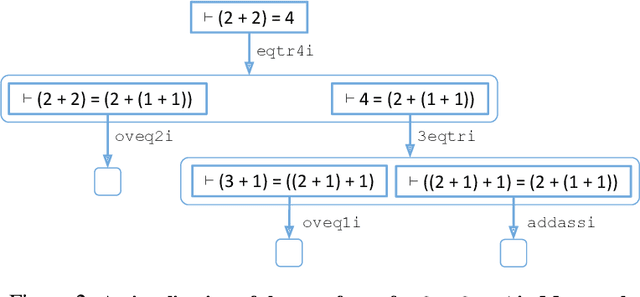

Abstract:We propose an online training procedure for a transformer-based automated theorem prover. Our approach leverages a new search algorithm, HyperTree Proof Search (HTPS), inspired by the recent success of AlphaZero. Our model learns from previous proof searches through online training, allowing it to generalize to domains far from the training distribution. We report detailed ablations of our pipeline's main components by studying performance on three environments of increasing complexity. In particular, we show that with HTPS alone, a model trained on annotated proofs manages to prove 65.4% of a held-out set of Metamath theorems, significantly outperforming the previous state of the art of 56.5% by GPT-f. Online training on these unproved theorems increases accuracy to 82.6%. With a similar computational budget, we improve the state of the art on the Lean-based miniF2F-curriculum dataset from 31% to 42% proving accuracy.
End-to-end symbolic regression with transformers
Apr 22, 2022



Abstract:Symbolic regression, the task of predicting the mathematical expression of a function from the observation of its values, is a difficult task which usually involves a two-step procedure: predicting the "skeleton" of the expression up to the choice of numerical constants, then fitting the constants by optimizing a non-convex loss function. The dominant approach is genetic programming, which evolves candidates by iterating this subroutine a large number of times. Neural networks have recently been tasked to predict the correct skeleton in a single try, but remain much less powerful. In this paper, we challenge this two-step procedure, and task a Transformer to directly predict the full mathematical expression, constants included. One can subsequently refine the predicted constants by feeding them to the non-convex optimizer as an informed initialization. We present ablations to show that this end-to-end approach yields better results, sometimes even without the refinement step. We evaluate our model on problems from the SRBench benchmark and show that our model approaches the performance of state-of-the-art genetic programming with several orders of magnitude faster inference.
Deep Symbolic Regression for Recurrent Sequences
Jan 12, 2022



Abstract:Symbolic regression, i.e. predicting a function from the observation of its values, is well-known to be a challenging task. In this paper, we train Transformers to infer the function or recurrence relation underlying sequences of integers or floats, a typical task in human IQ tests which has hardly been tackled in the machine learning literature. We evaluate our integer model on a subset of OEIS sequences, and show that it outperforms built-in Mathematica functions for recurrence prediction. We also demonstrate that our float model is able to yield informative approximations of out-of-vocabulary functions and constants, e.g. $\operatorname{bessel0}(x)\approx \frac{\sin(x)+\cos(x)}{\sqrt{\pi x}}$ and $1.644934\approx \pi^2/6$. An interactive demonstration of our models is provided at https://bit.ly/3niE5FS.
Leveraging Automated Unit Tests for Unsupervised Code Translation
Oct 13, 2021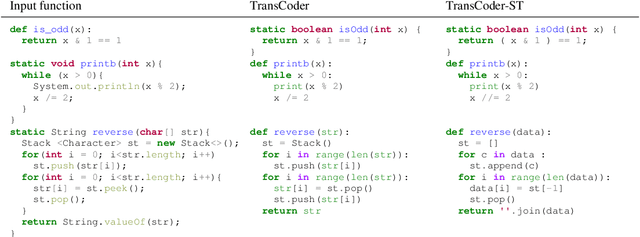

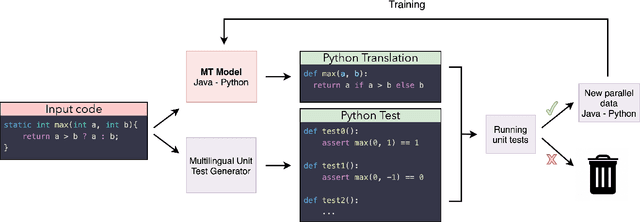

Abstract:With little to no parallel data available for programming languages, unsupervised methods are well-suited to source code translation. However, the majority of unsupervised machine translation approaches rely on back-translation, a method developed in the context of natural language translation and one that inherently involves training on noisy inputs. Unfortunately, source code is highly sensitive to small changes; a single token can result in compilation failures or erroneous programs, unlike natural languages where small inaccuracies may not change the meaning of a sentence. To address this issue, we propose to leverage an automated unit-testing system to filter out invalid translations, thereby creating a fully tested parallel corpus. We found that fine-tuning an unsupervised model with this filtered data set significantly reduces the noise in the translations so-generated, comfortably outperforming the state-of-the-art for all language pairs studied. In particular, for Java $\to$ Python and Python $\to$ C++ we outperform the best previous methods by more than 16% and 24% respectively, reducing the error rate by more than 35%.
DOBF: A Deobfuscation Pre-Training Objective for Programming Languages
Feb 16, 2021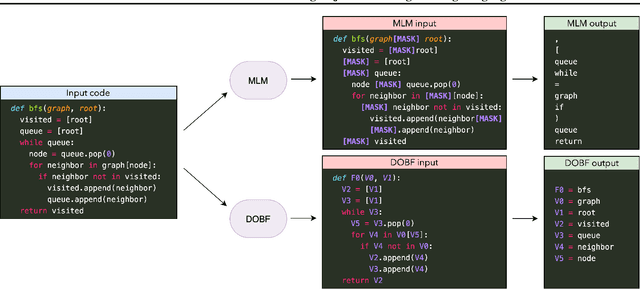
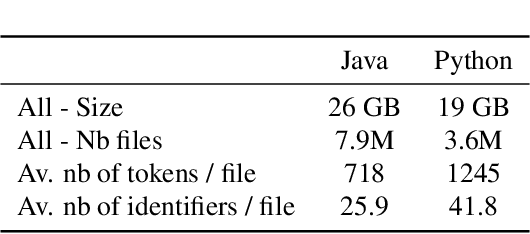
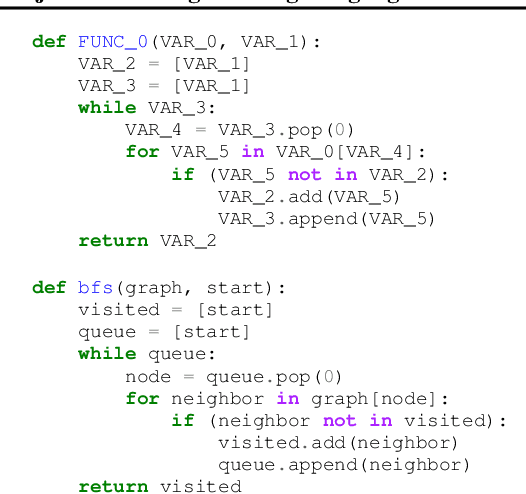
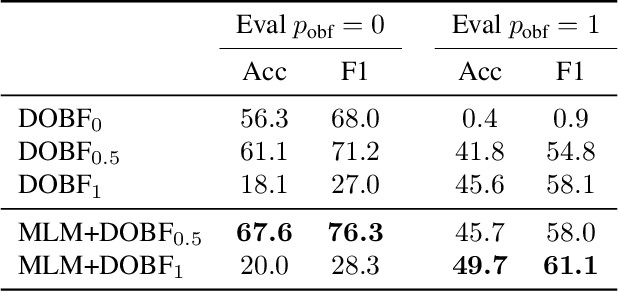
Abstract:Recent advances in self-supervised learning have dramatically improved the state of the art on a wide variety of tasks. However, research in language model pre-training has mostly focused on natural languages, and it is unclear whether models like BERT and its variants provide the best pre-training when applied to other modalities, such as source code. In this paper, we introduce a new pre-training objective, DOBF, that leverages the structural aspect of programming languages and pre-trains a model to recover the original version of obfuscated source code. We show that models pre-trained with DOBF significantly outperform existing approaches on multiple downstream tasks, providing relative improvements of up to 13% in unsupervised code translation, and 24% in natural language code search. Incidentally, we found that our pre-trained model is able to de-obfuscate fully obfuscated source files, and to suggest descriptive variable names.
 Add to Chrome
Add to Chrome Add to Firefox
Add to Firefox Add to Edge
Add to Edge